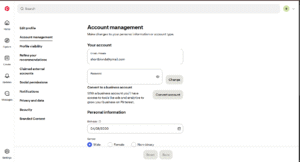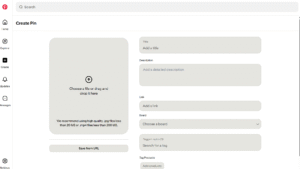Pinterest Affiliate Marketing: A Step-by-Step Guide for Beginners
Imagine earning money while you sleep — that’s the power of affiliate marketing. When combined with Pinterest, one of the most visual and search-friendly platforms, it becomes a powerful source of passive income. Whether you’re a blogger, content creator, or entrepreneur, this guide will walk you through everything you need to start earning with Pinterest affiliate marketing.
Step 1: Create a Pinterest Business Account
To get started, head over to Pinterest for Business. Use your brand name and a professional profile picture. If you have a website, claim it to boost credibility and enable Pinterest Analytics to track your growth. A business account gives you access to features that personal accounts don’t, like analytics, ads, and rich pins.

Step 2: Join Affiliate Programs
Next, join reputable affiliate networks. Some trusted options include:
Choose programs that match your niche. For example, if your focus is tech, pick tech-related products. If it’s beauty, go for skincare or makeup brands. The goal is to promote products your audience genuinely wants.
Step 3: Choose a Profitable Niche
Selecting a niche is critical. Popular niches with strong buying intent include:
-
Home Decor
-
Fitness & Health
-
Beauty & Skincare
-
Tech & Gadgets
-
DIY & Crafts
-
Digital Tools (like AI software or design apps)
✅ Tip: Pick a niche you’re genuinely interested in — it makes content creation enjoyable and sustainable.

Step 4: Create Eye-Catching Pins
Your pins need to stand out. Use tools like Canva or Adobe Express to design vertical images (1000x1500px). Some design tips:
-
Add text overlays highlighting benefits (e.g., “Top 5 Amazon Kitchen Must-Haves”).
-
Use bright colors and readable fonts.
-
Keep your branding consistent across pins.
Step 5: Write Compelling Pin Descriptions
Descriptions help Pinterest understand your content and improve search visibility. Include:
-
Keywords for SEO
-
Benefit-driven description
-
Call-to-action (e.g., “Click to discover the best deals!”)
Example:
“Looking for budget-friendly home decor ideas? Discover these 7 Amazon finds that make your home look luxurious — without breaking the bank! #homedecor #amazonfinds”
Step 6: Place Your Affiliate Links
You can:
-
Directly link to affiliate products (if allowed).
-
Link to a blog post or YouTube video with embedded affiliate links — safer for long-term growth.
⚠️ Always include a disclosure:
“This post contains affiliate links, meaning I may earn a small commission at no extra cost to you.”
Step 7: Drive More Traffic to Your Pins
-
Post consistently (5–10 pins/day).
-
Use Pinterest SEO in titles, descriptions, and board names.
-
Join Pinterest Group Boards and Tailwind Communities.
-
Repin your own content to increase visibility.
Step 8: Track and Optimize Your Performance
Use Pinterest Analytics to identify your best-performing pins. Focus on:
-
Designs that attract clicks
-
Keywords that drive traffic
-
Low-performing pins can be refreshed with new images or titles
Consistently improving your content will grow your affiliate earnings over time.
Step 9: Understand Your Earnings Potential
Income varies depending on niche and traffic. Beginners can earn $100–$500/month, while experienced creators can reach $2,000+ per month with consistent effort and optimization.
Step 10: Common Mistakes to Avoid
-
Ignoring Pinterest SEO
-
Spamming affiliate links
-
Not disclosing affiliate partnerships
-
Using low-quality images
-
Inconsistent posting schedule
Step 11: Tools That Make Your Life Easier
-
Canva – design stunning pins
-
Tailwind – schedule and analyze pins
-
Bitly – track affiliate links
-
Pinterest Trends – discover trending topics
-
ChatGPT – quickly generate titles, descriptions, and pin ideas
Pinterest affiliate marketing is all about creating value for your audience while promoting products they’ll love. By following this step-by-step guide and staying consistent, you can build a profitable, long-term passive income stream.

Your words feel like they’ve been chosen with the utmost care — each one placed to guide us towards greater understanding.